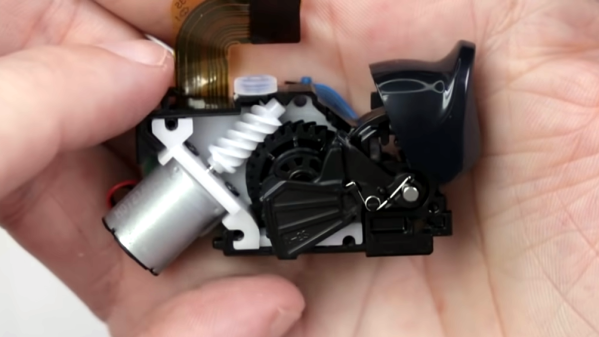Sony’s Playstation 5 console and its DualSense controllers aren’t exactly new, but the triggers of the controllers have a genuinely interesting design that is worth examining. The analog triggers on the PS5 controllers are generally described as having “variable resistance”, but it turns out that’s not the whole story. Not only is the trigger capable of variable resistance when being pressed, but it can also push back in variable ways and with varying amounts of force. How it works is pretty clever.
 The feedback for the trigger assembly is handled by a lever, a geared wheel, and a worm gear on an electric motor. Under normal circumstances, nothing interferes with the trigger at all and it works like a normal analog trigger. But when the motor moves the lever into place, trigger movement now has to overcome the added interference with a mechanical disadvantage. The amount of resistance felt can be increased a surprising amount by having the motor actively apply additional force to counter the trigger’s movement.
The feedback for the trigger assembly is handled by a lever, a geared wheel, and a worm gear on an electric motor. Under normal circumstances, nothing interferes with the trigger at all and it works like a normal analog trigger. But when the motor moves the lever into place, trigger movement now has to overcome the added interference with a mechanical disadvantage. The amount of resistance felt can be increased a surprising amount by having the motor actively apply additional force to counter the trigger’s movement.
That’s not all, either. The motor can also actively move the lever into (or out of) position, which means that pulling the trigger not only has the ability to feel smooth, mushy, or stiff in different places, but it can also actively push back. This feedback can be introduced (or removed) at any arbitrary point along the trigger’s range of motion. A trigger pull can therefore feel like it has a sharp breakpoint, a rough travel, a hard stop, an active recoil, or any combination of those at any time.
It’s a little hard to describe, but you can get a better idea of it all works in practice by watching part of this teardown by [TronicsFix] (video cued to about 9:17 where the trigger teardown begins.) It’s also embedded below, so give it a peek.
A small amount of force applied in the right place can produce outsized results, but a force feedback project doesn’t have to be subtle. One can always shake things up by mounting a whole bunch of solenoids onto a mouse.
Continue reading “How The PS5’s Genuinely Clever Adaptive Triggers Work”











